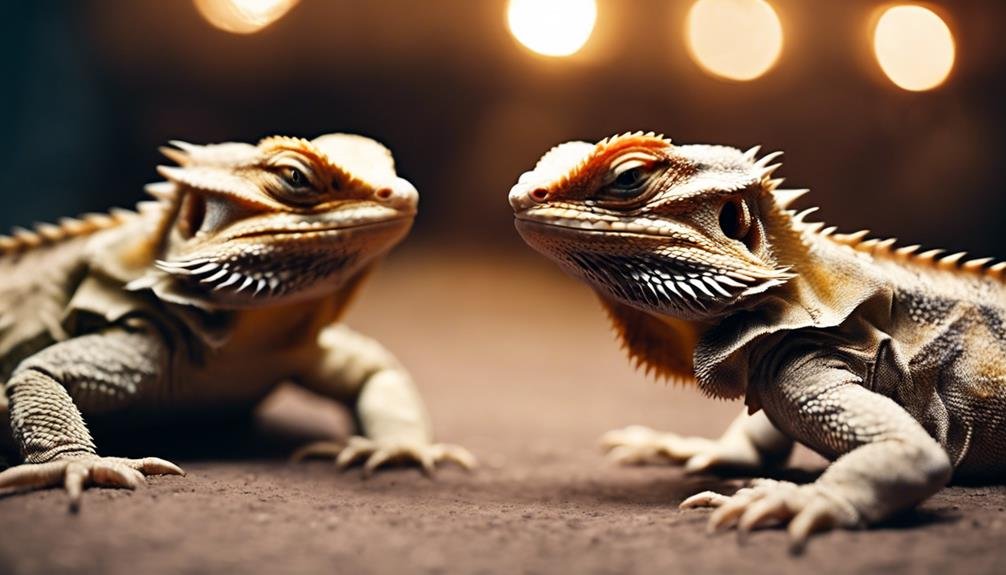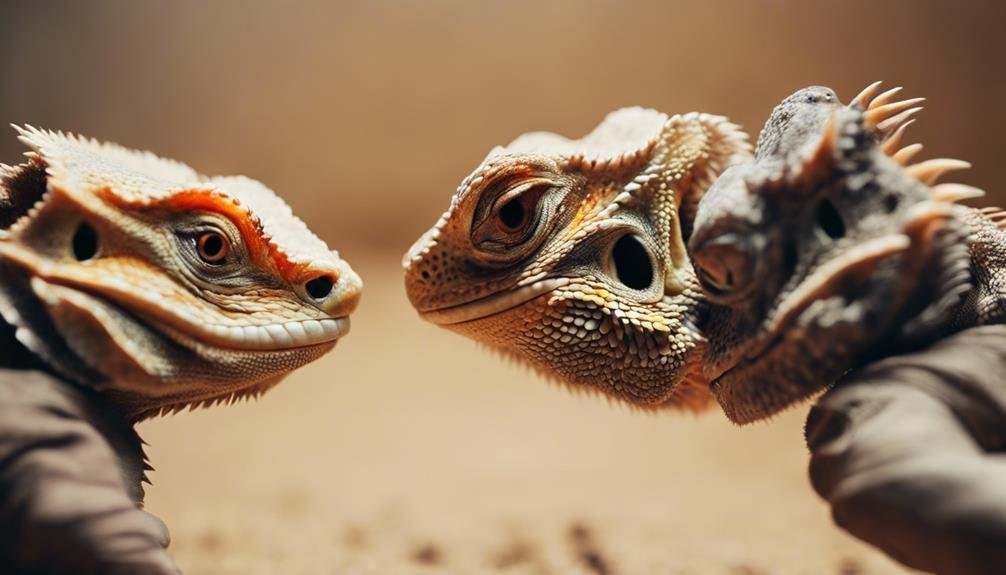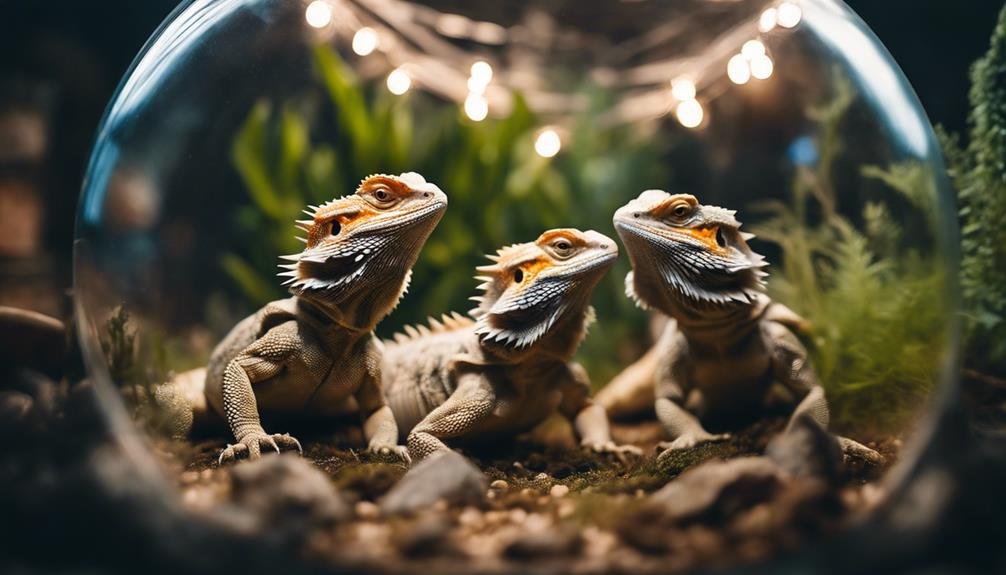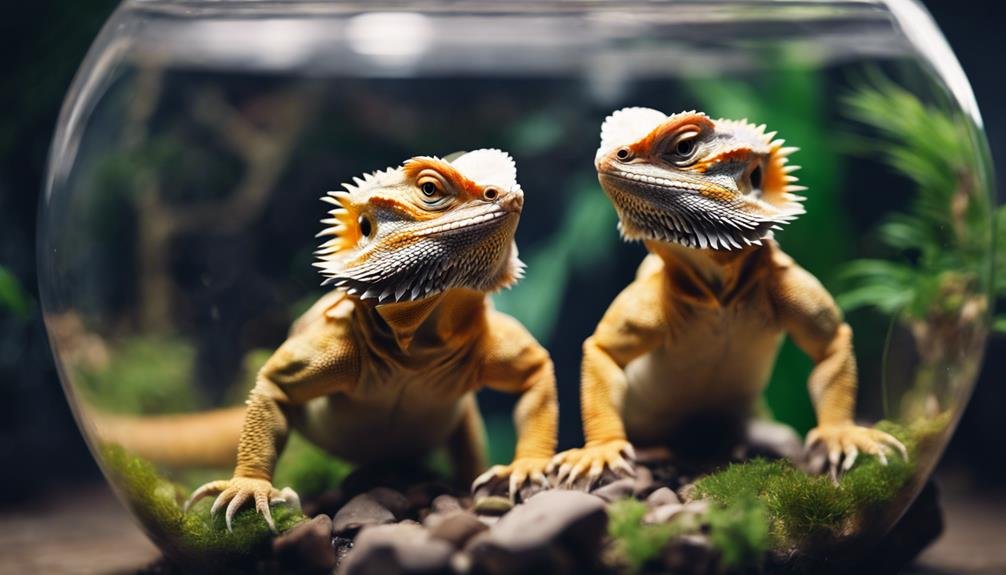When you’re planning to introduce two bearded dragons, it’s crucial to navigate tempers and tantrums with a sense of precision. You’ve got to establish a neutral ground where neither dragon feels at home, as this minimizes territorial aggression. Carefully monitor their initial interactions for signs of dominance or distress, such as puffing up or attempting to bite. These early moments are critical in setting the tone for their future relationship. But what do you do if signs of aggression escalate? Understanding the subtleties of their behavior and knowing when to intervene can make all the difference, leaving you wondering how to promote a peaceful cohabitation.
Key Takeaways
- Select a neutral territory for the first introduction to avoid triggering territorial aggression.
- Monitor for signs of stress or aggression, such as puffing up or darkening of the beard.
- Introduce the dragons to each other in short, supervised sessions, gradually increasing their time together.
- Provide hiding spots and visual barriers in the enclosure to help reduce stress and aggression.
- Immediately separate the dragons if aggressive behavior escalates to prevent injury.
Understanding Bearded Dragon Behavior
To effectively introduce two bearded dragons, it’s important to understand their behavior, as they can show stress, discomfort, or territorial aggression through specific actions and body language. Bearded dragons may throw what seems like temper tantrums, signaling their unease or territoriality. Recognizing these signs is vital to prevent stress and guarantee a smooth introduction between them.
When your bearded dragons puff up their bodies, it’s not just for show. This behavior, along with darkening their beards and adopting aggressive postures, is their way of expressing distress or asserting dominance. It’s their form of throwing a temper tantrum, indicating they’re not comfortable with the current situation. By paying close attention to these cues, you can better understand what your bearded dragons are trying to communicate.
Creating a comfortable environment plays a significant role in minimizing these temper tantrums. Ensuring the right lighting, temperature, and providing enough hiding spots can make a big difference in their demeanor. However, if you’re ever unsure or concerned about your bearded dragons’ behavior, don’t hesitate to consult with a reptile veterinarian or an experienced reptile keeper for guidance.
Preparing Neutral Territory
Before introducing your bearded dragons, it’s important to set up a neutral space that doesn’t belong to either of them. This guarantees they’re on equal footing, reducing the chance of territorial disputes or aggression.
Selecting Neutral Ground
When introducing two bearded dragons, it’s important to select a neutral area that neither has claimed, ensuring a smoother initial interaction. Make sure to use a separate enclosure or space, where both can explore without feeling the need to defend territory. This method prevents the likelihood of territorial aggression, allowing them to meet on equal footing.
Put together an environment that includes hiding spots and visual barriers, so they can have a moment out of sight if they feel stressed, giving them an ‘eyes closed‘ option to retreat. It’s vital to monitor their behavior closely, watching for any signs of aggression like puffing up, head bobbing, or biting attempts.
This careful observation helps in managing their introduction process effectively, ensuring it goes as smoothly as possible.
Ensuring Safe Interaction
After establishing a neutral territory, place both bearded dragons in it simultaneously to guarantee a fair start and avoid any dominance issues. This is important for preventing one from claiming the area as their own before the other arrives.
You’ll need to supervise every single moment of their initial encounter to make sure they’re not showing signs of aggression towards each other. It’s vital to keep these first interactions brief, gradually increasing the time they spend together. This method helps them get used to one another’s presence without overwhelming them.
If you observe any aggression, stress, or dominance behavior, be ready to separate them immediately. Your vigilance during these early stages is key to a successful introduction and ensuring their safety.
First Meetings: What to Expect


Anticipation fills the air as you prepare to introduce two Bearded Dragons, signaling the start of a delicate process where initial territorial behavior and dominance displays are common. This moment is pivotal, laying the groundwork for their future relationship and social dynamics. Understanding that Bearded Dragons are inherently territorial will help you navigate this introduction. You’ll likely witness a range of behaviors aimed at establishing a dominance hierarchy, including but not limited to, posturing and physical displays intended to assert control over space and resources.
Be prepared for potential aggression, especially among males, who may vie more intensely for dominance. Such interactions are important for them to sort out their social standings, but you must be vigilant to make sure these displays don’t escalate into harmful confrontations. Watching for signs of aggression without intervening immediately allows them a chance to set their own social order. However, it’s crucial to be ready to step in and separate them if things turn too aggressive, to prevent injuries or undue stress. This initial meeting is a critical step in their cohabitation, setting the tone for their relationship moving forward.
Monitoring Body Language
Understanding your bearded dragons’ body language is essential as it reveals their feelings and intentions during the introduction process. By monitoring reactions and communication styles, you’ll be able to interpret their body language cues and behavioral changes effectively. This insight helps in ensuring a smoother introduction, reducing stress and aggression.
| Behavior | Meaning | Action |
|---|---|---|
| Head bobbing, puffing up, darkening of the beard | Aggression indicators | Monitor closely, consider separation |
| Arm waving, flattening of the body, avoiding eye contact | Submissive signals | Encourage, provide safe spaces |
| Tail whipping, biting | Territorial displays | Be cautious, potentially separate |
| Hiding, loss of appetite, increased pacing | Stress indicators | Reduce stressors, monitor health |
It’s vital to recognize these signs early on. Aggression indicators and territorial displays suggest that one dragon feels threatened or is trying to assert dominance. Submissive signals, while less alarming, still require your attention to make sure the submissive dragon does not feel overly stressed. Stress indicators are a clear sign that the introduction might be too overwhelming. By staying observant and responsive to these cues, you’ll navigate the introduction process with a better understanding of their needs and comfort levels.
Handling Aggression and Dominance


When introducing two bearded dragons, it’s important to closely monitor their body language for any signs of aggression or dominance to ensure a safe and positive meeting. Recognizing behaviors like head bobbing and puffing up is key for aggression management. Establishing a neutral territory for the initial introduction can greatly reduce the likelihood of territorial disputes, playing a crucial role in managing dominance dynamics.
Should you observe any aggressive behavior or dominance displays, it’s necessary to:
- Separate the dragons immediately to prevent injuries.
- Reintroduce them gradually in short, supervised sessions to better gauge their reactions.
- Consult with a reptile behavior expert if aggressive or dominant behaviors persist despite your efforts.
These steps are essential for effective behavior observation and ensuring the well-being of both dragons. Ignoring such signs can lead to stress, injury, or worse for the animals involved. By being proactive in handling aggression and dominance, you’re laying the groundwork for a potentially harmonious relationship between your bearded dragons, or at the very least, preventing harmful interactions.
Gradual Familiarization Techniques
Initiating gradual familiarization between bearded dragons begins with placing them in separate enclosures where they can see each other. This first step allows for visual recognition without immediate physical contact, which is important for a smooth introduction. You’re not just letting them glance at each other; you’re setting the stage for a calm, controlled meeting.
Next, incorporate scent swapping by exchanging items like bedding or decor between their enclosures. This technique gets them used to each other’s scent, reducing the shock of a new presence. It’s like letting them know about their future friend without the pressure of a face-to-face encounter.
Once they’re somewhat accustomed to each other’s sight and smell, it’s time for supervised interactions in a neutral territory. Choose a space neither dragon considers its own to minimize territorial disputes. During these meetings, keep an eye out for any signs of aggression, stress, or dominance. It’s all about ensuring their safety while they explore this new relationship.
Remember to provide separate hiding spots and ample space during these introductions. This gives them a chance to retreat if they feel overwhelmed, preventing territorial disputes from escalating. It’s all about patience and careful observation as you guide them through this process.
Ensuring Long-Term Compatibility


To ensure long-term compatibility between bearded dragons, it’s vital to introduce them in a neutral territory and closely monitor their interactions for signs of aggression or stress. Compatibility assessment begins with understanding their body language. Head bobbing or arm waving can indicate either dominance or submission, which plays a critical role in their relationship dynamics. If you notice any signs of stress or aggression, such as biting or relentless chasing, it’s important to separate them immediately to prevent injury.
Ensuring a harmonious living environment involves:
- Behavioral observation: Continuously monitor their interactions beyond the initial meeting. Look for signs of mutual tolerance or affection, like sharing basking spots without signs of aggression.
- Territory establishment: In their shared enclosure, provide multiple basking spots and hides. This allows each dragon to claim its own space, reducing conflicts over territory.
- Consideration of age, size, and gender: These factors are crucial in reducing conflict. Typically, dragons of similar size and age coexist more peacefully. However, mixing genders can lead to dominance issues, especially during breeding seasons.
Will Baby Bearded Dragons Eventually Get Along if Introduced Properly?
When introducing baby bearded dragons, it’s important to understand their bonding behaviors. With proper introduction and care, baby bearded dragons can eventually get along. Providing enough space, monitoring their interactions, and ensuring they have separate hiding spots can help promote successful bonding between baby bearded dragons.
Frequently Asked Questions
How Do You Calm an Angry Bearded Dragon?
To guarantee a comfortable, familiar, and enriched environment for a bearded dragon, approach them calmly, avoiding sudden movements to prevent further stress. Use a gentle voice and slow movements, offering treats to distract and calm them.
Handling stress involves understanding their comfort zones and providing environmental enrichment to address the root causes of aggression. Remember, they might act out if they feel threatened or territorial.
How Do You Socialize an Aggressive Bearded Dragon?
To socialize an aggressive bearded dragon, you’ll need to focus on its diet, habitat setup, and regular health checkups. Start by ensuring they’re getting the right nutrition, as a balanced diet can affect their behavior.
Next, create a comfortable and spacious habitat with plenty of hiding spots to reduce stress.
Can You Introduce 2 Bearded Dragons?
Yes, you can introduce two bearded dragons, but it’s important to do it carefully. Start with health checks to confirm both are disease-free.
Then, prepare their habitat, providing ample space and separate basking spots to minimize stress. Initially, monitor their encounters closely to catch any signs of aggression early.
If tempers flare, be ready to separate them to prevent injuries. Taking these steps helps make the introduction smoother and safer for both dragons.
What Do Bearded Dragons Do When They’re Mad?
When your bearded dragon’s mad, you’ll notice some clear signs. They might change colors, showing darker shades or a black beard, signaling they’re not happy.
Tail twitching and head bobbing are also common signs of agitation or aggression. These behaviors are their way of communicating discomfort or stress.
It’s important to pay attention to these cues to understand their feelings and respond appropriately to keep them calm and happy.
Conclusion
To sum up, introducing two bearded dragons can be smooth sailing if you’re attentive to their needs and signals. By setting up a neutral space and closely observing their interactions, you’ll help them get comfortable with each other.
Remember, it’s all about patience and understanding their body language to prevent any fights. Gradually, they’ll familiarize themselves with one another, paving the way for a peaceful coexistence.
Keep these tips in mind, and you’re on track for a successful introduction.


